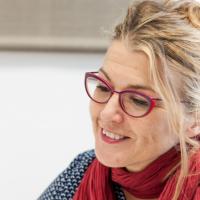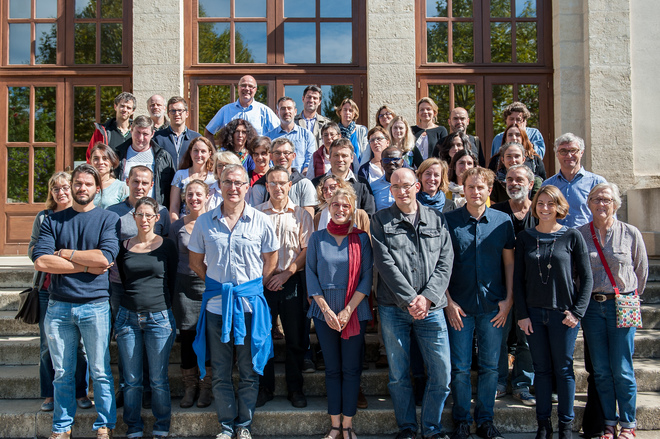
Bioeconomy Reading time 5 min
Nathalie Gontard, the total package
Published on 01 December 2019
“Why packaging? I’m not entirely sure. Perhaps because it was uncharted territory in the 1990s.” With her red bag and cycling helmet in hand, the youthful Nathalie Gontard is not one given to much self-reflection. “After getting my associate’s degree, I was focused on two things: packaging and developing countries. Thirty years later and much to my delight, I’ve been able to bring together an international research community to address the issue of plastic packaging and waste”. In packaging as in life, Nathalie’s outlook is very broad. In the 1970s, there was a huge appetite for plastic. It was practical and cheap. But no one was thinking about the heaps of waste that would end up in the earth or the plastic particles that would assail the oceans. Just like on her husband’s boat, Nathalie is charting a course in this field that looks well beyond the horizon. It is imperative not only to have a very long term view when considering the future outcomes of plastic, it is also necessary to recycle plastics as much as possible and to develop plant-based, biodegradable packaging.
No Agro-Waste
Three quarters of all plastics cannot be repeatedly recycled — hence the importance of developing biodegradable packaging. But not all biodegradable packaging is created equal. Just because a product is plant-based, doesn’t automatically mean it is praiseworthy. For example, food packaging can be made out of maize granulate, but if the maize is grown in China in competition with food products, then the product does not have much merit. The idea is to create bioproducts from local, unvalued plant waste, such as grapevine prunings and olive husks. It is also possible to use dairy and winery waste to produce both methane for energy and packaging bioproducts through the use of microorganisms. This is the force driving No Agro-Waste, a major project that Nathalie coordinates over 32 countries, including China, with a budget of €8 million. “This project is innovative because we are researching ways to use modelling to assess all the lifecycle impacts a product can have. — And doing so before the fact, not after the product is developed,” Nathalie is quick to point out. The goal is to produce packaging that has an overall positive impact.
Inspiration from afar
In Japan, no one saw me as a woman, just a foreigner
“Fear begets tunnel vision and gets in the way of long-term thinking,” says Nathalie. But fear is one thing she learnt to overcome very early on. After her associate’s degree, she set out round the world seeking inspiration. She travelled through Africa, South America and Asia on her own, trepidatious but with courage in her convictions. She spent ten years studying the use of leaves to wrap food, a traditional practice in these areas. Food can be wrapped in the leaves of various tree species, some of which even change colour when the food inside has spoilt, a handy way to keep track of freshness. With support from CIRAD, she created interdisciplinary teams and set up laboratories in Congo and Benin to study leaf-wrapping industries that were coming under threat by plastic packaging products. In Japan, Nathalie studied “smart” packaging. During her thesis, she discovered a wheat protein that changes its physical and electrical properties in the presence of CO2, ammonium and ethanol. While this protein cannot be used in packaging itself, it is an excellent indicator of food breaking down as it spoils. This gave Nathalie the idea of using the protein to create an RFID chip for monitoring the build-up of these elements and to create a more realistic expiry date. It is another tool in the fight against food waste and a fine example of innovation making inroads into industrial processes.
“INRA is an amazing organisation serving agriculture and agri-food, both in France and around the world”
Nathalie is an optimist who believes in working collaboratively. She has passed her international perspective onto her team, and beyond. Multiple cooperative projects are constantly on the go and Skype is almost always on in the laboratories. In 1999, Nathalie set her travelling bags down at the University of Montpellier, later becoming a researcher at INRA Montpellier in 2011. Nathalie’s roots are in Ardèche, in central France, where her parents were models of living a simple, self-sufficient life in close communion with nature. Nathalie gets a bit emotional when talking about her father, a plumber, gardener, fisherman and truffle expert. From a founding father and two brothers deeply connected to the land, Nathalie imparted a way of life on to two adventurous children with spartan lifestyles — a pilot and a diver — and two children with social and environmental sensibilities. It is also easy to understand what led her to her life’s work on plant-based, biodegradable packaging.

- 53 years old
- 1983: Science-stream secondary school diploma
- 1983–1985: Associate’s degree from the Montpellier Institute of Technology
- 1985–1988: Engineering and Master’s degree
- 1988–1991: Ph.D. at the University of Montpellier, post-doctorate from Norwich University
- 1992–1998: Researcher at CIRAD, lecturer at the Tropical Food Industries Division at ENSIA (renamed AgroParisTech, now under Montpellier SupAgro)
- 1998–1999: Researcher at Uji University, Japan
- 2000–2010: Professor at the University of Montpellier
- 2010: Professor at Kyoto University, Japan
- Since 2011: research director, Agropolymer Engineering and Emerging Technologies Unit, INRA Montpellier
- Over 150 publications, numerous awards and prizes, including the Horizon 2020 Étoile de l’Europe Award in 2015
- Hobbies: reading, cycling, swimming, sailing, dance
